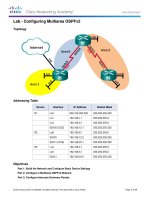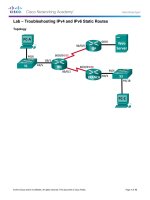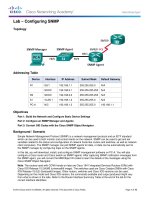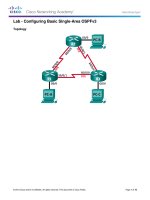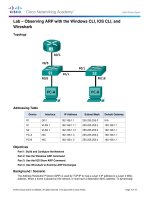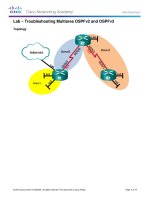en CN lab ILM kho tài liệu bách khoa
Bạn đang xem bản rút gọn của tài liệu. Xem và tải ngay bản đầy đủ của tài liệu tại đây (6.89 MB, 282 trang )
CCNA Routing and Switching:
Connecting Networks
Instructor Lab Manual
This document is exclusive property of Cisco Systems, Inc. Permission is granted
to print and copy this document for non-commercial distribution and exclusive
use by instructors in the CCNA Routing and Switching: Connecting Networks course
as part of an official Cisco Networking Academy Program.
Design Hierarchy (Instructor Version)
Instructor Note: Red font color or Gray highlights indicate text that appears in the instructor copy only.
Objective
Identify the three layers of a hierarchical network and how they are used in network design.
Instructor Note: This activity can be completed individually or in small groups.
Scenario
A network administrator is tasked with designing an expanded network for the company.
After speaking with network administrators in other branches of the company, it was decided to use the Cisco
three-layer hierarchical network design model to guide the expansion. This model was chosen for its simple
influence upon network planning.
The three layers of the expanded network design include:
Access
Distribution
Core
Resources
World Wide Web access
Presentation software
Step 1: Use the Internet to research the Cisco three-layer design model for images only.
a. Find two images that show the three-layer hierarchical design model.
b. Note the online image’s web address.
Step 2: Study the two images you have selected from Step 1.
a. Notice the types of equipment in each layer of the designs you have chosen.
b. Differentiate why it is assumed the types of equipment shown in the images are located where they are
on the design.
c.
Notice any other differences between the chosen images.
1) Number of devices used within the layers
2) Redundancy, if any
Step 3: Create a three-slide presentation to include:
a. The two chosen designs with hyperlinks as to their Internet site locations.
b. A statement on each slide as to why the particular image was chosen.
c.
Comparison statements as to how the two images differ, but with an explanation of why they are
classified as three-level hierarchical designs.
© 2013 Cisco and/or its affiliates. All rights reserved. This document is Cisco Public.
Page 1 of 4
Design Hierarchy
Step 4: Present the slides to a classmate, another group, or the class for discussion.
Suggested Activity Example (no model numbers are given, as emphasis is on the
hierarchical functions of the network devices shown):
Slide 1:
Graphic 1
Student or Group Notes as to why this graphic was chosen:
Access layer shows basic switches, Spanning Tree options, redundancy to the Distribution layer, and security
considerations.
Distribution layer shows redundancy, load balancing, and routing protocols linked to the Core layer.
Core layer shows load balancing, redundancy, routing protocols, and port aggregation.
© 2013 Cisco and/or its affiliates. All rights reserved. This document is Cisco Public.
Page 2 of 4
Design Hierarchy
Slide 2:
Graphic 2
Student or Group Notes as to why this graphic was chosen:
Access layer shows PCs, access switches, VPN gateways, printers, teleworker, home office, and wireless
router. Also shown in this layer are redundant links to the distribution layer.
The distribution layer shows several multilayer switches and link connections to the core layer.
The core layer shows multilayer switches and connections to the distribution layer and the cloud.
Slide 3:
Basic equipment types are located in the access layer, closest to the user and work with the distribution layer
above it. Most of the network devices are located at this level on both images.
The distribution layer equipment interfaces with both core and access layers in both images. This hierarchical
level seems to contain the most sophisticated and multifunctional equipment. Redundancy is clearly apparent
to both core and access layers as shown in the first model. It would seem that high-powered multifunction
© 2013 Cisco and/or its affiliates. All rights reserved. This document is Cisco Public.
Page 3 of 4
Design Hierarchy
switches would be located at this level of the two graphics. The number of network devices shown in both
graphics at this level is smaller than the access layer, but larger than the core layer.
As shown in the two previous graphics, the core layer has the most sophisticated equipment. There are fewer
network devices at this layer, which seems to indicate that the devices are highly functioning and fast traffic
processors.
Identify elements of the model that map to IT-related content:
Cisco hierarchical design-model levels
-
Access
-
Distribution
-
Core
Types of equipment located in the layers of the
hierarchy
Amount of equipment located in the layers of the
hierarchy
Cisco hierarchical design model functions
© 2013 Cisco and/or its affiliates. All rights reserved. This document is Cisco Public.
Page 4 of 4
Borderless Innovations – Everywhere (Instructor Version)
Instructor Note: Red font color or Gray highlights indicate text that appears in the instructor copy only.
Objective
Describe borderless networks components.
Instructor Note: This activity can be completed individually or in small or large groups.
Scenario
You are the network administrator for your small- to medium-sized business. Borderless network services interest
you as you plan your network’s future.
While planning for network policies and services, you realize that your wired and wireless networks need
manageability and deployment design.
Therefore, this leads you to consider the following Cisco borderless services as possible options for your
business:
Security – TrustSec
Mobility – Motion
Application Performance – App Velocity
Multimedia Performance – Medianet
Energy Management – EnergyWise
Resources
World Wide Web access
Word processing or presentation software
Directions
Step 1: Select three Cisco borderless network services that interest you from the following list:
Security – TrustSec
Mobility – Motion
Application performance – App Velocity
Multimedia performance – Medianet
Energy management – EnergyWise
Step 2: Using the Internet, research your three selections. Consider finding short video
presentations and various websites of the three borderless network services you
selected. Be sure to take notes on your research:
a. Based on your research, create a basic definition of each borderless network service.
b. List at least three areas of assistance each borderless service offers to network administrators.
© 2013 Cisco and/or its affiliates. All rights reserved. This document is Cisco Public.
Page 1 of 3
Borderless Innovations - Everywhere
Step 3: Prepare an informational matrix listing the three borderless network services you
selected. Include the video notes you completed in Steps 2a and b.
Step 4: Share your matrix with another student, group, or the entire class.
Note: As students listen to group presentations, they can take notes and submit them to the Instructor.
Suggested Activity Example (student designs will vary):
Borderless Network
Service
Security – TrustSec
The Power of Cisco ISE
Basic Definition
Borderless Services Offered
A comprehensive borderless network
service that focuses on security for
wired and wireless networks.
Centralized security management.
Choices for security management
policies implementation.
Provides a log for security
violations, in both live and
historical formats.
It is transparent to users.
Cisco Identity Services Engine
Mobility – Motion
Cisco Data In Motion
A borderless network service that
allows network administrators to
gather data from sensors, mobile
devices, and video cameras to help
make decisions and communicate in
real-time.
Connects IoE borderless data from
manufacturing floors, energy grids,
healthcare facilities, and
transportation systems.
Consolidates data to help
customers improve data
operations, while saving valuable
time and money.
Helps businesses share data and
build a business case for change.
Data in Motion
Application performance
– App Velocity
Application Velocity
A borderless network service that
uses application-based delivery
systems to enhance communications
between businesses, customers, and
clients.
Delivers real-time, languagetranslation services
Allows businesses to use network
applications to share research and
communicate new ideas to each
other
Centralizes network applications
for simplified delivery and
management, reducing operational
costs
Application Performance
Management Service
© 2013 Cisco and/or its affiliates. All rights reserved. This document is Cisco Public.
Page 2 of 3
Borderless Innovations - Everywhere
Multimedia performance
– Medianet
Video-ready Network
with Cisco MediaNet
A borderless network service which
allows for easy wired and wireless
configuration, media monitoring, and
low-cost multimedia operations.
Keeps track of multimedia traffic
that flows on the network.
Helps reduce operating costs with
fast troubleshooting of video,
voice, and data errors.
Enables precise assessment of the
impact that video, voice, and data
have on the network.
Medianet Architecture
Energy management –
EnergyWise
Lights Out - Cisco
EnergyWise
A borderless network service that
reduces energy costs by using wired
and wireless devices.
Enables communications in real
time internationally using wired
and wireless device delivery
systems.
Saves energy costs by delivering
information quickly and efficiently.
Saves energy and time by
deploying network services instead
of using collective human
resources efforts.
Borderless Networks video
Identify elements of the model that map to IT-related content:
Borderless network services
-
Security – TrustSec
-
Mobility – Motion
-
Application performance – App Velocity
-
Multimedia performance – Medianet
-
Energy management – EnergyWise
Policy strategy planning for borderless network services
© 2013 Cisco and/or its affiliates. All rights reserved. This document is Cisco Public.
Page 3 of 3
Branching Out (Instructor Version)
Instructor Note: Red font color or Gray highlights indicate text that appears in the instructor copy only.
Objective
Describe WAN access technologies available to small-to-medium-sized business networks.
Instructor Note:
This activity is can be completed individually or in small groups – it can then be shared and discussed
with another group of students, with the entire class, or with the instructor.
At this point of the curriculum, students should learn that there are different types of network equipment
more suited for sizes of networks rather than which specific models of equipment should be considered
for purchase.
Scenario
Your medium-sized company is opening a new branch office to serve a wider, client-based network. This branch
will focus on regular, day-to-day network operations, but will also provide TelePresence, web conferencing, IP
telephony, video on demand, and wireless services.
Although you know that an ISP can provide WAN routers and switches to accommodate the branch office
connectivity for the network, you prefer to use your own customer premises equipment (CPE). To ensure
interoperability, Cisco devices have been used in all other branch-office WANs.
As the branch-office network administrator, it is your responsibility to research possible network devices for
purchase and use over the WAN.
Resources
World Wide Web
Word processing software
Directions
Step 1:
Visit the Cisco Branch-WAN Business Calculator site. Accept the agreement to use the
calculator.
Step 2: Input information to help the calculator determine a preferred router or ISR option for
your branch and WAN (both).
Note: There is a slider tool within the calculator window that allows the choice of more service options for your
branch office and WAN.
Step 3: The calculator will suggest a possible router or ISR device solution for your branch
office and WAN. Use the tabs at the top of the calculator window to view the output.
Step 4: Create a matrix with three column headings and list some information provided by the
output in each category:
Return on investment (ROI)
Total cost of ownership (TCO)
Energy savings
© 2013 Cisco and/or its affiliates. All rights reserved. This document is Cisco Public.
Page 1 of 2
Branching Out
Step 5: Discuss your research with a classmate, group, class, or your instructor. Include in
your discussion:
Specifics on the requirements of your network as used for calculator input
Output information from your matrix
Additional factors you would consider before purchasing a router or ISR for your new branch office
Suggested Activity Example Solution:
Instructor Notes: (information will vary for each group depending on calculator information specified)
Suggested routers or ISRs for the branch and WAN office: ______________________
Return on Investment
Total Cost of Ownership
Energy Savings
(output notes will vary per group depending on WAN considerations and services specified)
Identify elements of the model that map to IT-related content:
WAN locations and sizes
Devices used on the WAN
Cost of ownership for WAN CPE devices
WAN energy savings (green technology)
© 2013 Cisco and/or its affiliates. All rights reserved. This document is Cisco Public.
Page 2 of 2
Lab – Researching WAN Technologies (Instructor Version)
Instructor Note: Red font color or Gray highlights indicate text that appears in the instructor copy only.
Objectives
Part 1: Investigate Dedicated WAN Technologies and Providers
Part 2: Investigate a Dedicated Leased Line Service Provider in Your Area
Background / Scenario
Today’s broadband Internet services are fast, affordable, and secure using VPN technologies. However,
many companies still find the need for a 24-hour dedicated connection to the Internet or a dedicated point-topoint connection from one office location to another. In this lab, you will investigate the cost and availability of
purchasing a dedicated T1 Internet connection for your home or business.
Required Resources
Device with Internet access
Part 1: Investigate Dedicated WAN Technologies and Providers
In Part 1, you will research basic characteristics of dedicated WAN technologies, and in Step 2, you will
discover providers that offer dedicated WAN services.
Step 1: Research WAN technology characteristics.
Use search engines and websites to research the following WAN technologies to complete the table below.
Last Mile Media
WAN Technology
Dedicated
Connection
(yes/no)
Copper
(yes/no)
Fiber
(yes/no)
Wireless
(yes/no)
Speed/Range
T1/DS1
yes
yes
yes
yes
1.544 Mb/s
T3/DS3
yes
yes
yes
yes
44.736 Mb/s
OC3 (SONET)
yes
no
yes
no
155.52 Mb/s
Frame Relay
yes
yes
yes
yes
56 Kb/s - 1.544 Mb/s
ATM
yes
yes
yes
yes
155 Mb/s – 622 Mb/s
MPLS
yes
yes
yes
yes
Up to 10 Gb/s
EPL (Ethernet Private Line)
yes
yes
yes
no
Up to 10 Gb/s
Step 2: Discover dedicated WAN technology service providers.
Navigate to This webpage lists the Internet service providers (also
known as carriers) that partner with Telarus to provide automated real-time telecom pricing. Click the links to
the various carrier partners and search for the dedicated WAN technologies that they provide. Complete the
table below by identifying each service provider’s dedicated WAN services, based on the information provided
on the website. Use the extra lines provided in the table to record additional service providers.
© 2013 Cisco and/or its affiliates. All rights reserved. This document is Cisco Public.
Page 1 of 5
Lab – Researching WAN Technologies
Internet Service
Provider
T1/DS1/PRI
T3/DS3
OC3
(SONET)
Frame
Relay
ATM
MPLS
EPL
Ethernet Private Line
Comcast
Integra
x
x
tw telecom
x
x
x
x
x
x
x
AT&T
Cbeyond
Earthlink
Level 3
Communications
XO
Communications
Verizon
Part 2: Investigate a Dedicated Leased Line Service Provider in Your Area
In Part 2, you will research a local service provider that will provide a T1 dedicated leased line to the
geographical area specified. This application requires a name, address, and phone number before the search
can be performed. You may wish to use your current information or research an address locally where a
business might be looking for a WAN connection.
Step 1: Navigate to to try GeoQuote.
GeoQuote is a web application that automates the search for WAN technology service providers, and
provides price quotes in real-time. Fill in the required fields.
a. Click the Service Type drop-down list and select Data (High Speed Internet).
b. Type your First Name and Last Name, your sample Company, and your Email address.
c.
Type the Phone Number to connect to the WAN. This number should be a landline number.
d. Click the button marked Step 2.
© 2013 Cisco and/or its affiliates. All rights reserved. This document is Cisco Public.
Page 2 of 5
Lab – Researching WAN Technologies
Step 2: Select the service type.
Choose Internet T1 (1.5 MB) and scroll down to Step 3 on the webpage.
© 2013 Cisco and/or its affiliates. All rights reserved. This document is Cisco Public.
Page 3 of 5
Lab – Researching WAN Technologies
Step 3: Enter installation information.
a. In the Installation BTN field, enter your sample business telephone number. This should be a landline
number.
b. Enter your address, city, state, and zip code.
Step 4: Enter contact preferences.
a. Do not click the first radio button (Please call me ASAP at), but do provide your contact telephone
number.
b. Click the I am just window shopping radio button.
c.
Click Continue.
Step 5: Examine the results.
You should see a list of quotes showing the available pricing of a T1 connection to the location you specified.
Was the pricing in the area you chose comparable to those pictured below?
_______________________________________________________________________________________
_______________________________________________________________________________________
Answers will vary depending on service location and availability.
What was the range of prices from your results?
_______________________________________________________________________________________
_______________________________________________________________________________________
Answers will vary depending on service location and availability.
© 2013 Cisco and/or its affiliates. All rights reserved. This document is Cisco Public.
Page 4 of 5
Lab – Researching WAN Technologies
Reflection
1. What are the disadvantages to using a T1 leased line for personal home use? What would be a better
solution?
_______________________________________________________________________________________
A symmetrical service such as T1 would be more expensive and unnecessary for home use. Home users
typically do much more downloading than uploading and an asymmetrical service such as DSL or Cable could
provide faster downloads at a more affordable price.
2. When might the use of a dedicated WAN connection, of any type, be a good connectivity solution for a
business.
_______________________________________________________________________________________
Answers will vary. A business, which requires fast Internet speeds, both download and upload, and an
uninterrupted connection would benefit from a dedicated connection.
3. Describe other WAN technologies that provide high-speed, low-cost options that could be an alternative
solution to a T1 connection.
_______________________________________________________________________________________
Frame Relay, MPLS, and Metro Ethernet or Ethernet Private Line (EPL) are technologies that would be worth
researching.
© 2013 Cisco and/or its affiliates. All rights reserved. This document is Cisco Public.
Page 5 of 5
WAN Device Modules (Instructor Version)
Instructor Note: Red font color or Gray highlights indicate text that appears in the instructor copy only.
Objective
Select WAN access technologies to satisfy business requirements in a small-to-medium-sized business network.
Instructor Note: This activity can be completed individually or in small groups – it can then be shared and
discussed with another group of students, with the entire class, or with the instructor.
Scenario
Your medium-sized company is upgrading its network. To make the most of the equipment currently in use, you
decide to purchase WAN modules instead of new equipment.
All branch offices use either Cisco 1900 or 2911 series ISRs. You will be updating these routers in several
locations. Each branch has its own ISP requirements to consider.
To update the devices, focus on the following WAN modules access types:
•
Ethernet
•
Broadband
•
T1/E1 and ISDN PRI
•
BRI
•
Serial
•
T1 and E1 Trunk Voice and WAN
•
Wireless LANs and WANs
Resources
World Wide Web
Word processing software
Directions
Step 1: Visit Interfaces and Modules. On this page, you will see many options ISR interface
modules options – remember that you currently own and use only the Cisco 1900 and
2900 series routers.
Note: If the above link is no longer valid, search the Cisco site for “Interfaces and Modules”.
Step 2: Create a comparison matrix listing the following WAN access types for your branch
networks:
Ethernet
Broadband
T1/E1 and ISDN PRI
BRI
Serial WAN
© 2013 Cisco and/or its affiliates. All rights reserved. This document is Cisco Public.
Page 1 of 5
WAN Device Modules
T1 and E1Trunk Voice and WAN
Wireless LANs and WANs
Step 3: In the matrix, record the interface module type you need to purchase for your ISRs for
upgrade purposes.
Step 4: Use the Internet to research pictures of the modules. Provide a screenshot of the
module or a hyperlink to a picture of each module.
Step 5: Share your matrix with a classmate, group, class, or your instructor.
Suggested Activity Example Solution:
Instructor Notes:
This is a good place to have students discuss the terminology. For instance, WIC2T = WAN Interface Card
with 2 serial ports.
Students can also add various cards to routers in PT and use commands such as show ip interface brief to
view the changes.
Please encourage students to read the datasheet information listed on the modular card graphics sites – they
will become familiar with different interface types by doing so.
All graphics will vary as shown in the students’ final matrix – the graphics shown in this Activity Example
Solution are representative in nature and were copied from the Cisco products sites. Each graphic is
hyperlinked to the source available at the time this activity was created.
© 2013 Cisco and/or its affiliates. All rights reserved. This document is Cisco Public.
Page 2 of 5
WAN Device Modules
WAN
Access
Type
2900 and 1900 Series Module
Availability
EHWIC 1-port dual mode
SFP(100M/1G) or
GE(10M/100M/1G)*
2-port 10/100 Routed-Port
HWIC
Multimode
VDSL2/ADSL/2/2+ EHWIC
Annex (A, B, and M
variations)*
Multimode EFM/ATM
SHDSL EHWIC
4-pair G.SHDSL HWIC with
2-wire, 4-wire, and 8-wire
support or 2-pair G.SHDSL
HWIC with 2-wire and 4-wire
support
Ethernet
Broadband
Module (interface card) Example
(* from Column 2 indicates the graphic shown)
(for use with 2900 series only)
T1/E1 and
ISDN PRI
2-port Channelized
E1/T1/ISDN PRI HWIC*
1-port Channelized
E1/T1/ISDN PRI HWIC
(for use with 2900 series only)
2-port VIC card-BRI (NT and
TE
(for use with 2900 and 1900
series)
BRI
4-port ISDN BRI High-Speed
WAN Interface Card*
1-port ISDN BRI U HighSpeed WAN Interface Card
1-port ISDN WAN Interface
Card (dial and leased line)
© 2013 Cisco and/or its affiliates. All rights reserved. This document is Cisco Public.
Page 3 of 5
WAN Device Modules
(for use with 2900 series only)
One-port clear-channel
T3/E3 Service Module
4-port clear-channel T1/E1
HWIC
4-port serial HWI
(for use with 2900 and 1900
series)
Serial
1-Port 4-Wire 56/64 Kpbs
CSU/DSU WAN Interface
Card
1-Port T1/Fractional T1
DSU/CSU High-Speed WAN
Interface Card*
1-Port Serial High-Speed
WAN Interface Card
2-Port Serial High-Speed
WAN Interface Card
1
T1/E1
Trunk
Voice and
WAN
Wireless
LANs and
WAN
1-port T1/E1 Voice / WAN w/
D&I & unstructured E1
1
(G703)
2-port T1/E1 Voice / WAN w/
Drop & Insert
1-port T1/E1 Voice / WAN w/
2
Drop & Insert
2-port T1/E1 Voice / WAN w/
D&I & unstructured E1
(G703)
1-port T1/E1 Voice / WAN w/
D&I & unstructured E1
(G703)
Dedicated 4G LTE EHWIC
for Verizon Wireless
Network, US (Verizon SKU)
operates on LTE at 700MHz
(band 13) with GPS
4G LTE EHWIC for AT&T,
700 MHz Band 17,
850/1900/2100 MHz
UMTS/HSPA
4G LTE EHWIC for Europe,
LTE 800/900/1800/
2100/2600 MHz,
900/1900/2100 MHz
UMTS/HSPA bands
(non-US) 3.7G HSPA+
Release 7 EHWIC w/
2
© 2013 Cisco and/or its affiliates. All rights reserved. This document is Cisco Public.
Page 4 of 5
WAN Device Modules
SMS/GPS (MC8705)
ATT HSPA+ R7 EHWIC with
SMS/GPS based on
MC8705
3.5G EHWIC (Non-US)
HSPA/UMTS
850/900/1900/2100MHz with
SMS/GPS
3G EHWIC Verizon EV-DO
Rev A/0/1xRTT
800/1900MHz with
SMS/GPS
3G EHWIC Sprint EV-DO
Rev A/0/1xRTT
800/1900MHz with
SMS/GPS
3G EHWIC BSNL EV-DO
Rev A/0/1xRTT
800/1900MHz with
SMS/GPS
3G (for India only) HWIC
TATA EVDO Rev A/0/1xRTT
800/1900MH
Identify elements of the model that map to IT-related content:
WAN modular interfaces
Network card interface types
ISR module availability by model type
© 2013 Cisco and/or its affiliates. All rights reserved. This document is Cisco Public.
Page 5 of 5
PPP Persuasion (Instructor Version)
Instructor Note: Red font color or Gray highlights indicate text that appears in the instructor copy only.
Objectives
Describe the benefits of using PPP over HDLC in a WAN.
This activity can be completed individually or in small groups of 2-3 students per group.
Scenario
Your network engineering supervisor recently attended a networking conference where Layer 2 protocols were
discussed. He knows that you have Cisco equipment on the premises, but he would also like to offer security and
advanced TCP/IP options and controls on that same equipment by using the Point-to-Point Protocol (PPP).
After researching the PPP protocol, you find it offers some advantages over the HDLC protocol, currently used on
your network.
Create a matrix listing the advantages and disadvantages of using the HDLC vs. PPP protocols. When comparing
the two protocols, include:
Ease of configuration
Adaptability to non-proprietary network equipment
Security options
Bandwidth usage and compression
Bandwidth consolidation
Share your chart with another student or class. Justify whether or not you would suggest sharing the matrix with
the network engineering supervisor to justify a change being made from HDLC to PPP for Layer 2 network
connectivity.
Resources
Internet access to the World Wide Web
Word processing or spreadsheet software
Instructor - Suggested Model Example and Resources
Internet Sites/Resources:
3 WAN Protocols You Should Know
RFC 1661
© 2013 Cisco and/or its affiliates. All rights reserved. This document is Cisco Public.
Page 1 of 2
PPP Persuasion
HDLC and PPP Comparison Chart
Criteria
HDLC
PPP
Ease of Configuration
Standard or default for all Cisco
equipment
Can be simple or more involved,
depending upon the PPP options
chosen to implement
Adaptability to Non-Proprietary
Network Equipment
Not adaptable to other non-Cisco
devices
Adaptable to other non-proprietary
devices
Security Options
Not offered
CHAP (encrypted and secure link
passwords) or PAP (non-encrypted
link passwords)
Bandwidth Usage and Compression
Standard TDM and no compression
Compression available
Bandwidth Consolidation
Standard serial bandwidth used on
one connection
Different connections can be
bundled to offer higher bandwidth
and traffic throughput
Identify elements of the model that map to IT-related content:
PPP
HDLC
CHAP
PAP
TDM
STDM
Bandwidth compression
Bandwidth consolidation
© 2013 Cisco and/or its affiliates. All rights reserved. This document is Cisco Public.
Page 2 of 2
Lab – Configuring Basic PPP with Authentication (Instructor
Version)
Instructor Note: Red font color or Gray highlights indicate text that appears in the instructor copy only.
Topology
© 2013 Cisco and/or its affiliates. All rights reserved. This document is Cisco Public.
Page 1 of 27
Lab – Configuring Basic PPP with Authentication
Addressing Table
Device
Branch1
Interface
IP Address
Subnet Mask
Default Gateway
G0/1
192.168.1.1
255.255.255.0
N/A
S0/0/0 (DCE)
10.1.1.1
255.255.255.252
N/A
S0/0/0
10.1.1.2
255.255.255.252
N/A
S0/0/1 (DCE)
10.2.2.2
255.255.255.252
N/A
Lo0
209.165.200.225
255.255.255.224
N/A
G0/1
192.168.3.1
255.255.255.0
N/A
S0/0/1
10.2.2.1
255.255.255.252
N/A
PC-A
NIC
192.168.1.3
255.255.255.0
192.168.1.1
PC-C
NIC
192.168.3.3
255.255.255.0
192.168.3.1
Central
Branch3
Objectives
Part 1: Configure Basic Device Settings
Part 2: Configure PPP Encapsulation
Part 3: Configure PPP CHAP Authentication
Background / Scenario
The Point-to-Point Protocol (PPP) is a very common Layer 2 WAN protocol. PPP can be used to connect from
LANs to service provider WANs and for connection of LAN segments within an enterprise network.
In this lab, you will configure PPP encapsulation on dedicated serial links between the branch routers and a
central router. You will configure PPP Challenge Handshake Authentication Protocol (CHAP) on the PPP
serial links. You will also examine the effects of the encapsulation and authentication changes on the status of
the serial link.
Note: The routers used with CCNA hands-on labs are Cisco 1941 Integrated Services Routers (ISRs) with
Cisco IOS Release 15.2(4)M3 (universalk9 image). The switches used are Cisco Catalyst 2960s with Cisco
IOS Release 15.0(2) (lanbasek9 image). Other routers, switches, and Cisco IOS versions can be used.
Depending on the model and Cisco IOS version, the commands available and output produced might vary
from what is shown in the labs. Refer to the Router Interface Summary Table at the end of this lab for the
correct interface identifiers.
Note: Make sure that the routers and switches have been erased and have no startup configurations. If you
are unsure, contact your instructor.
Instructor Note: Refer to the Instructor Lab Manual for the procedures to initialize and reload devices.
Required Resources
3 Routers (Cisco 1941 with Cisco IOS Release 15.2(4)M3 universal image or comparable)
2 Switches (Cisco 2960 with Cisco IOS Release 15.0(2) lanbasek9 image or comparable)
2 PCs (Windows 7, Vista, or XP with terminal emulation program, such as Tera Term)
Console cables to configure the Cisco IOS devices via the console ports
Ethernet and serial cables as shown in the topology
© 2013 Cisco and/or its affiliates. All rights reserved. This document is Cisco Public.
Page 2 of 27
Lab – Configuring Basic PPP with Authentication
Part 1: Configure Basic Device Settings
In Part 1, you will set up the network topology and configure basic router settings, such as the interface IP
addresses, routing, device access, and passwords.
Step 1: Cable the network as shown in the topology.
Attach the devices as shown in the Topology, and cable as necessary.
Step 2: Initialize and reload the routers and switches.
Step 3: Configure basic settings for each router.
a. Disable DNS lookup.
b. Configure the device name.
c.
Encrypt plain text passwords.
d. Create a message of the day (MOTD) banner warning users that unauthorized access is prohibited.
e. Assign class as the encrypted privileged EXEC mode password.
f.
Assign cisco as the console and vty password and enable login.
g. Set console logging to synchronous mode.
h. Apply the IP addresses to Serial and Gigabit Ethernet interfaces according to the Addressing Table and
activate the physical interfaces.
i.
Set the clock rate to 128000 for DCE serial interfaces.
j.
Create Loopback0 on the Central router to simulate access to the Internet and assign an IP address
according to the Addressing Table.
Step 4: Configure routing.
a. Enable single-area OSPF on the routers and use a process ID of 1. Add all the networks, except
209.165.200.224/27 into the OSPF process.
b. Configure a default route to the simulated Internet on the Central router using Lo0 as the exit interface
and redistribute this route into the OSPF process.
c.
Issue the show ip route ospf, show ip ospf interface brief, and show ip ospf neighbor commands on
all routers to verify that OSPF is configured correctly. Take note of the router ID for each router.
Branch1:
Branch1# show ip route ospf
Codes: L - local, C - connected, S - static, R - RIP, M - mobile, B - BGP
D - EIGRP, EX - EIGRP external, O - OSPF, IA - OSPF inter area
N1 - OSPF NSSA external type 1, N2 - OSPF NSSA external type 2
E1 - OSPF external type 1, E2 - OSPF external type 2
i - IS-IS, su - IS-IS summary, L1 - IS-IS level-1, L2 - IS-IS level-2
ia - IS-IS inter area, * - candidate default, U - per-user static route
o - ODR, P - periodic downloaded static route, H - NHRP, l - LISP
+ - replicated route, % - next hop override
Gateway of last resort is 10.1.1.2 to network 0.0.0.0
© 2013 Cisco and/or its affiliates. All rights reserved. This document is Cisco Public.
Page 3 of 27


